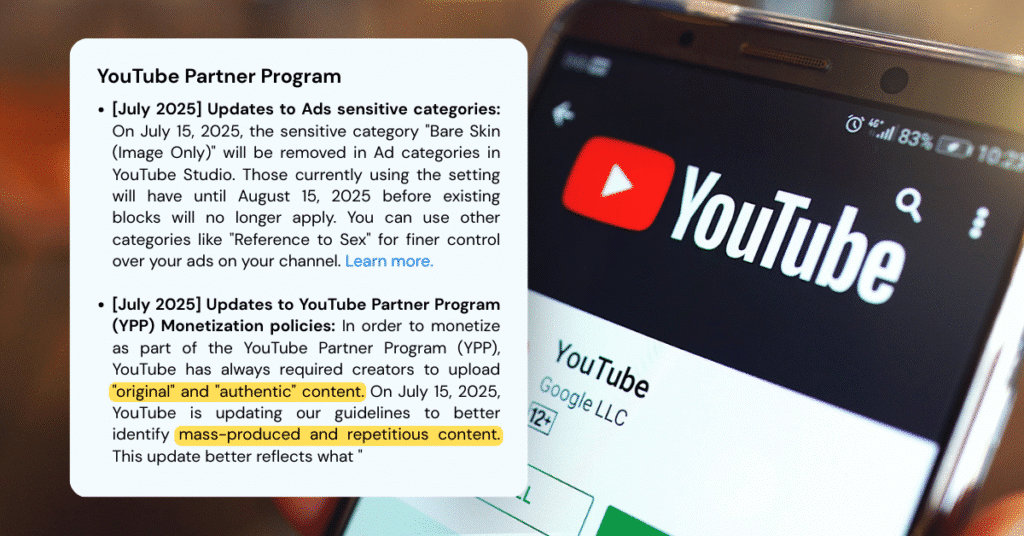Share:

On 15th July 2025, we might see a change in YouTube’s monetization policies. They will target the income of the repetitive, mass-produced, carbon inchprints and AI generated content. The changes aim to protect content quality across the platform and to improve clarity for creators who want to know what is monetizable under the YPP.
As AI tools continue to develop, it’s never been easier to produce masses of content through automation. The result is a rise of low-end videos that clutter the platform. Many of them consist of AI-generated voice overs, recycled clips or formulaic formats.
This sort of content, which is sometimes dubbed “AI slop,” has perturbed viewers and the platform itself. YouTube wants content creators to post genuine, original content, not automatically populated content with minimal effort and creativity.
On 15th July, YouTube will update its monetization policy in the YPP to provide more clarity around what is considered inauthentic and repetitive content. The rules themselves are not new, creators have long been required to post original content. This is a clarification, not a full policy reversal.
The aim is to boost detection and enforcement, particularly for creators that rely on shortcuts or automation tools.
After the announcement, some creators were concerned that popular formats like reaction videos, clip compilations or commentary content would be hit. However, YouTube’s Head of Editorial and Creator Liaison, Rene Ritchie, addressed these concerns.
Ritchie detailed in a video update:
“If you’re seeing posts about a July 2025 update to the YouTube Partner Program monetization policies and you’re concerned it’ll affect your reaction or clips or other type of channel. This is a minor update to YouTube’s long-standing YPP policies to help better identify when content is mass-produced or repetitive.”
As such, creators should still be able to monetize reused content, so long as it has added value, insights, or editing from the original.
For YouTube’s new enforcement efforts, those flagged are:
A duplicate but dressed up content published over and over in a group of tens.
This sort of content has long been nonviable for monetization. However, plenty of creators were flying under the radar. Now that enforcement will be tighter and more consistent.
YouTube describes inauthentic content as videos that are empty or worthless.
This includes:
There have already been cases of AI-generated viral video series, fake news videos and even a scam featuring deep fakes of public figures. YouTube’s new update hopes to address this trend before it damages the site’s public image.
Channels making “transformative” content such as videos that transform or repurpose content in a meaningful and creative way, are still eligible to be monetized.
These include:
With new content still added to the recycled content, the channel still falls within the updated policy.
To stay on the right side of the new rules, creators should:
Although YouTube is referring to this as a “minor” update, the impact could be significant for some creators. The platform is merely cracking down on rules that predated the blowback, especially now that AI tools have made it easier to mass-produce content.
The only reason you should be scared of this is if you are using join4join, sub4sub, gaming Google’s ad system, or take other shortcuts to creating videos leading to artificial manufactured views.
If you’re serious about making real videos, this update shouldn’t have any material effect. However, for anyone counting on shortcuts and automation, it’s time to reboot your approach.
If you want to future-proof your content strategy and stay compliant with YouTube’s evolving monetization policies, DigiEvolve Agency can help. From authentic content creation to monetization consulting, we ensure your YouTube channel grows the right way—ethically and sustainably.
Share:
DigiEvolve is a full-service digital marketing agency dedicated to helping businesses grow and succeed in the digital world.
Our team of experienced marketers, designers, and strategists work closely with clients to understand their goals and deliver customized marketing campaigns that boost visibility, increase engagement, and generate leads.